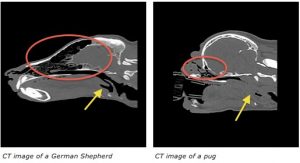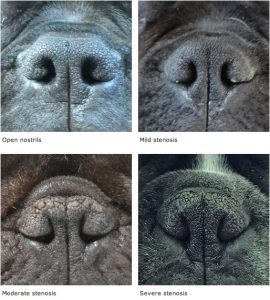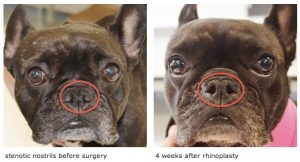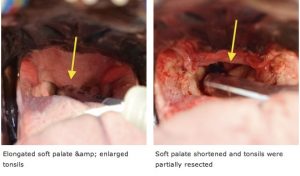With the rise in popularity of pugs and bulldog breeds we are seeing more and more dogs struggling to breath. We all know that Pugs, French and English bulldogs have noisy breathing but the key question is when does it become abnormal and what can we do about it?
These breeds are classified as brachycephalic because of their shortened nose.
We often forget to think about what is happening on the inside of our dogs, we just see their cute little faces.

These images show a comparison between a German Shepherd and a Pug. The area circled in red shows the nasal cavity and the sinuses, you see how little space there is in the pug compared to the German Shepherd. The yellow arrow points to the larynx and the soft palpate, in the pug the soft palpate is very long and thick compared to the German Shepherd this means the larynx can become obstructed by the soft palate and this makes breathing far more difficult for the pug.

Brachycephalic dogs often have very narrowed noses and that makes breathing feel like they are trying to breath through a narrow straw.
The pictures on the right show the degrees in narrowing of the nose, just imagine if your nose was like that!
Brachycephalic dogs can also have problems with sleeping, vomiting and regurgitation.
How can we test if the breathing is a significant problem?
We can do a 3-minute exercise tolerance test. All dogs should be able to trot at a speed of 3-5miles an hour for 3 continuous 3minutes without having any breathing difficulties/ loud noises. If your dog doesn’t pass this test then we may need to consider surgery.

We can perform surgery to help improve the clinical signs of airway obstruction.
Both the nose and the soft palate can be operated on to help relieve the obstruction.


Blog written by Penny Barnard-Brown BSc, BVetMed, MRCVS, PGCertSAS
